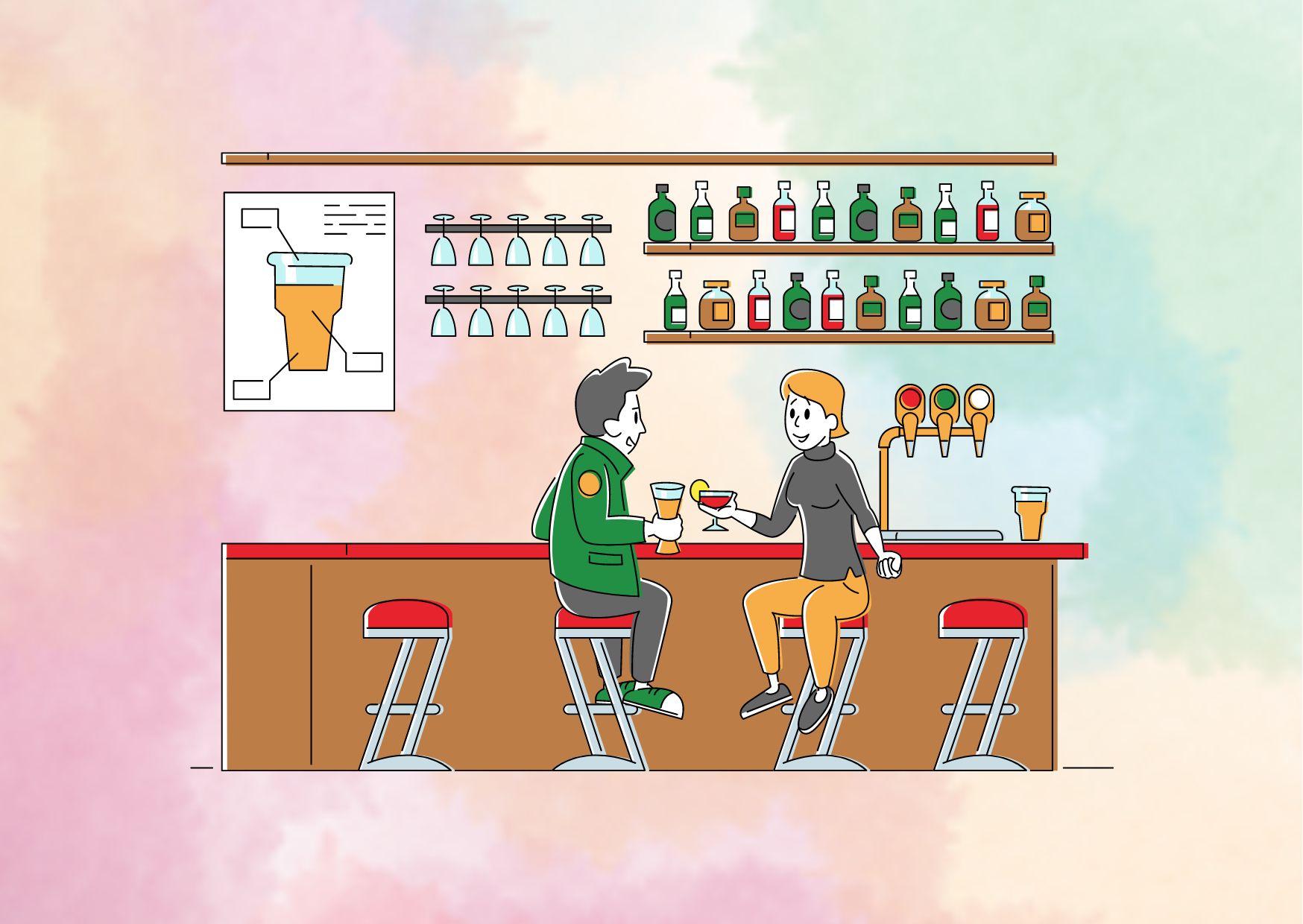Remember, the initial eye contact is just the first step in the triangle method. It sets the stage for the subsequent steps and lays the foundation for a successful flirtatious interaction. By choosing the right moment and maintaining a natural, inviting gaze, you increase your chances of capturing your partner’s interest and creating a sense of connection.
Step 2: Shift Your Gaze to Their Lips
After establishing initial eye contact, the next step in the triangle method is to shift your gaze to your partner’s lips. This subtle movement can signal a heightened level of interest or desire, as it mimics the natural behavior of someone considering a kiss.
Timing the transition
The timing of the transition from eye contact to lip gaze is crucial. It should be a smooth, natural movement, not an abrupt or prolonged stare. A general guideline is to hold eye contact for 1.5 to 2 seconds before allowing your gaze to drift down to their lips. Linger there for a brief moment, no more than a second or two, before returning your gaze to their eyes.
This brief glance at their lips can be a powerful nonverbal cue, suggesting a romantic or physical interest without being overtly suggestive. It’s a subtle way of conveying your attraction while still maintaining a level of mystery and intrigue.
Avoiding awkwardness
While the lip gaze is a key component of the triangle method, it’s important to avoid making your partner feel uncomfortable or self-conscious. Here are some tips to help you execute this step smoothly:
- Subtlety is key: The lip gaze should be a fleeting, almost imperceptible movement. Avoid staring or lingering too long, as this can come across as creepy or inappropriate.
- Timing is everything: Choose the right moment to shift your gaze. Avoid doing this in a group setting or when your partner is engaged in conversation with others. Stick to one-on-one interactions where they are focused on you.
- Read body language: Pay attention to your partner’s body language and facial expressions. If they seem uncomfortable or disinterested, it’s best to discontinue the triangle method and respect their boundaries.
- Practice makes perfect: Like any skill, mastering the lip gaze takes practice. Start by trying it in low-stakes situations, such as with friends or acquaintances, until you feel comfortable and confident in your execution.
By following these guidelines, you can smoothly transition from eye contact to a brief lip gaze, conveying interest and attraction without crossing any lines or making your partner feel uneasy.
Step 3: Complete the Triangle
Moving back to the eyes
After the brief lip gaze, the next step is to complete the triangle by moving your gaze back to your partner’s eyes. This final step solidifies the nonverbal cue and reinforces the sense of intimacy and connection you’ve established.
- From the lips, smoothly shift your gaze to your partner’s right eye. Hold eye contact for a brief moment, no more than a second or two.
- Then, without breaking the flow, move your gaze across to their left eye, again holding eye contact for a second or two.
This final eye movement completes the triangular pattern, creating a subtle yet powerful nonverbal signal that can heighten the flirtatious tension between you and your partner.
Creating a smooth motion
The key to executing the triangle method effectively is to ensure that your eye movements are smooth, natural, and seamless. Abrupt or jerky motions can disrupt the flow and potentially make your partner feel uncomfortable or self-conscious.
- Practice the triangle method in front of a mirror or with a friend to develop a fluid, natural rhythm. The transitions between eye contact, lip gaze, and eye movements should be seamless, almost imperceptible.
- Maintain a relaxed facial expression throughout the process. Avoid furrowing your brow or squinting, as these expressions can convey discomfort or intensity, which can undermine the subtlety of the technique.
- Breathe naturally and avoid holding your breath, as this can contribute to tension and disrupt the smooth flow of your eye movements.
By mastering the art of smooth, natural eye movements, you can execute the triangle method with confidence and finesse, effectively conveying your interest and creating a sense of intimacy without being overly overt or aggressive.
Remember, the triangle method is a subtle and nuanced technique. With practice and attention to detail, you can harness the power of nonverbal communication to enhance your flirting skills and increase your chances of making a lasting connection.
Suggestion for read: 8 Tips for Better Flirting
Step 4: Mastering the Technique
Executing the triangle method flawlessly requires practice and attention to detail. While the technique itself may seem simple, mastering the nuances can elevate your flirting game and increase your chances of success. Here are some practice tips and common mistakes to avoid as you embark on your journey to mastering the triangle method.
Practice Tips
- Slow and Steady: The key to a natural and seamless execution of the triangle method lies in the pace of your eye movements. Avoid rapid or jerky motions, as they can appear unsettling or distracting. Instead, move your gaze slowly and deliberately, allowing each transition to flow smoothly into the next.
- Mirror Practice: Before attempting the triangle method in a real-life situation, practice in front of a mirror. This will help you get a feel for the movements and ensure they appear natural and unforced. Observe your facial expressions and body language, and make adjustments as needed to maintain a relaxed and confident demeanor.
- Low-Stakes Rehearsal: Once you’ve practiced in front of the mirror, try the triangle method with close friends or acquaintances in low-stakes situations. This will help you gain confidence and receive valuable feedback on your execution. Remember, practice makes perfect, so don’t be discouraged if it feels awkward at first.
- Timing and Context: Pay close attention to the timing and context when using the triangle method. Initiate it during one-on-one interactions when your partner is engaged in conversation with you. Avoid using it in group settings or situations where it might be perceived as inappropriate or distracting.
Common Mistakes to Avoid
- Overusing the Technique: While the triangle method can be a powerful flirting tool, overreliance on it without integrating meaningful verbal communication or responding to your partner’s cues can make interactions feel forced or robotic. Aim for a balanced approach, using the technique as a complement to your overall flirting style.
- Misreading Signals: It’s crucial to be mindful of your partner’s body language and facial expressions. Misinterpreting friendly or polite gestures as romantic interest can lead to uncomfortable situations. Similarly, failing to recognize disinterest or discomfort can result in unintentionally pushing boundaries.
- Inappropriate Contexts: The triangle method may not be appropriate in certain settings, such as professional environments or formal occasions. Using it in these contexts could be perceived as unprofessional or disrespectful. Exercise good judgment and consider the appropriateness of the situation before employing the technique.
- Neglecting Personal Presentation: While the triangle method focuses on nonverbal communication, neglecting personal hygiene or dressing inappropriately for the occasion can undermine your efforts. Ensure that your appearance complements your flirting techniques and contributes to a positive overall impression.
- Lack of Practice: Attempting to use the triangle method without prior practice can lead to awkward execution, making it obvious and ineffective. Dedicate time to rehearsing and refining your skills to ensure a smooth and natural delivery.
Remember, mastering the triangle method is an ongoing process that requires patience, practice, and a willingness to learn from your experiences. By incorporating these tips and avoiding common pitfalls, you can enhance your flirting abilities and increase your chances of making meaningful connections.
Step 5: Reading Your Partner’s Response
Mastering the triangle method is not just about executing the technique flawlessly; it’s also about being attuned to your partner’s responses and adjusting your approach accordingly. By learning to read and interpret their body language and nonverbal cues, you can gage their level of interest and ensure that your flirtatious advances are well-received.
Positive Signs
When your partner is receptive to the triangle method, they may exhibit the following positive signs:
- Sustained Eye Contact: If they maintain eye contact throughout the interaction, it’s a good indication that they are engaged and interested.
- Mirroring Behavior: If your partner unconsciously mirrors your body language or eye movements, it suggests a connection and a desire to synchronize with you.
- Leaning In: If they lean in closer during the interaction, it’s a sign that they are comfortable with the level of intimacy and want to be closer to you.
- Positive Facial Expressions: Smiles, raised eyebrows, or a relaxed facial expression can indicate that your partner is enjoying the flirtatious exchange.
- Reciprocated Gestures: If your partner initiates their own version of the triangle method or engages in similar nonverbal flirting techniques, it’s a clear sign that they are interested and responsive to your advances.
Signals of Discomfort
While positive signs are encouraging, it’s equally important to recognize signals of discomfort or disinterest. Being attuned to these cues can help you avoid making your partner feel uncomfortable or crossing boundaries. Some common signals to watch out for include:
- Averted Gaze: If your partner consistently avoids eye contact or looks away during the interaction, it may indicate discomfort or a lack of interest.
- Closed-Off Body Language: Crossed arms, leaning away, or facing away from you can be signs that your partner is not receptive to the flirtatious advances.
- Nervous Gestures: Fidgeting, playing with hair, or touching the face repeatedly can be indicators of discomfort or anxiety.
- Forced Smiles or Frowns: If your partner’s facial expressions seem forced, strained, or disapproving, it’s a clear signal that they are not enjoying the interaction.
- Verbal Cues: If your partner explicitly expresses discomfort or asks you to stop, it’s essential to respect their boundaries and discontinue the triangle method immediately.
Remember, the triangle method is a subtle and nuanced technique, and its success relies heavily on your ability to read and respond to your partner’s cues. By being attuned to their responses, you can navigate the flirtatious interaction with confidence and respect, increasing your chances of creating a genuine connection.
Step 6: Incorporating the Triangle Method into Conversation
While the triangle method is a powerful nonverbal technique, it should not be used in isolation. To create a truly engaging and natural interaction, it’s essential to strike a balance between verbal and nonverbal cues. This section will guide you through the process of seamlessly integrating the triangle

